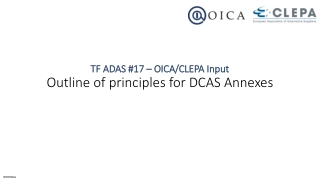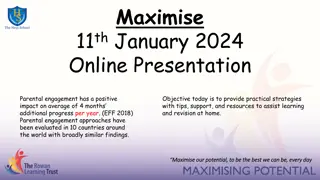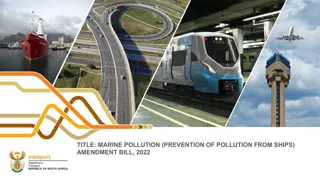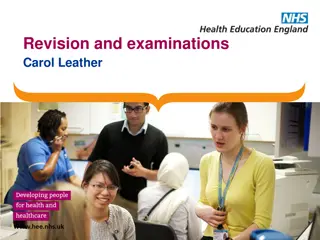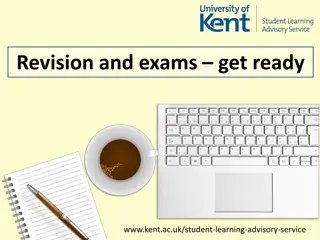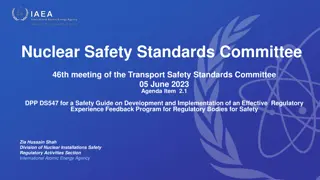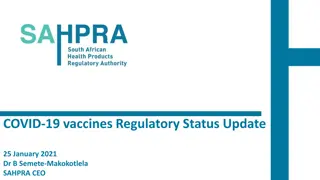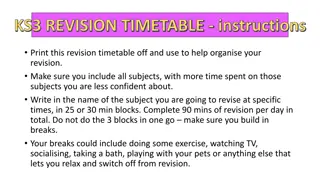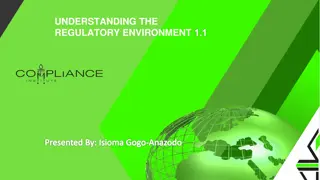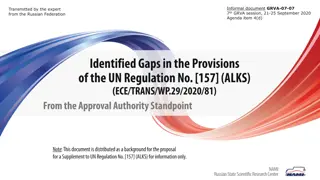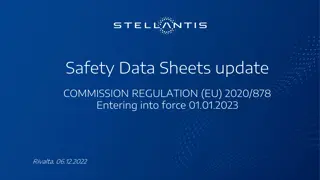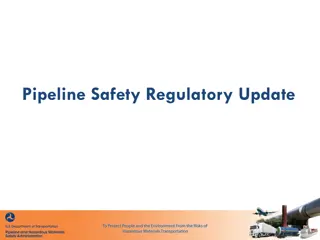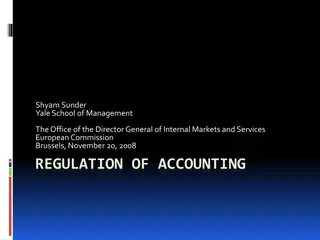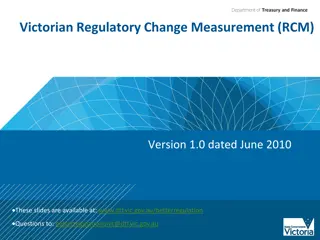Regulatory Update Overview: Annex 1 Revision and Stakeholders Overview
The regulatory update introduces the revision of Annex 1 by Greg McGurk on June 13th, 2018, emphasizing the history, process, and rationale for the revision. Key stakeholders, including regulatory bodies and industry players, are outlined, showcasing the global impact and need for alignment with current technologies. The revision process involves a combined working group evaluating the need for updates, introducing principles of Quality Risk Management and innovative technologies.
Download Presentation

Please find below an Image/Link to download the presentation.
The content on the website is provided AS IS for your information and personal use only. It may not be sold, licensed, or shared on other websites without obtaining consent from the author.If you encounter any issues during the download, it is possible that the publisher has removed the file from their server.
You are allowed to download the files provided on this website for personal or commercial use, subject to the condition that they are used lawfully. All files are the property of their respective owners.
The content on the website is provided AS IS for your information and personal use only. It may not be sold, licensed, or shared on other websites without obtaining consent from the author.
E N D
Presentation Transcript
Regulatory update Overview and Introduction Annex 1 Revision Greg McGurk, Senior Inspector Veterinary Medicines Information Day June 13th, 2018
Scope History Process of Revision Rationale for Revision Stakeholders Current status Key Points 13 JUNE 2018 2
Annex 1 - History, Process & Rationale for Revision
History First issued in 1971 Number of revisions since then, but not full revisions 2012 first proposal to revise Proposal Re-issued in 2014 13 JUNE 2018 4
Revision Process Combined Working Group EU, PICS and WHO Tasked with assessing need and extent for revision 3 Options: 1. Update Q&A 2. Revise Annex 1 3. Full Review & Rewrite 13 JUNE 2018 5
Rationale Introduction of principles of Quality Risk Management & Contamination Control Strategy New & Innovative processes & technologies: Reinforcing the need of manufacturers to keep up with current technologies Single use closed systems Disposable systems Rapid Microbial test methods Clarify ambiguities more detail needed Restructure more logical flow 13 JUNE 2018 6
Regulatory Stakeholders EU 28 member states PICS 54 Agencies (Human & Vet) WHO 194 members Relevant to the whole world 13 JUNE 2018 8
Industry Stakeholders Multiple technologies Automated processes, manual processes, BFS, Form Fill Seal, Lyo, LVP, SVP, Powders, Liquids Small Pharma Academic Institutes Virtual operations Big Pharma Hospitals 13 JUNE 2018 9
Annex 1 Working group UK Japan Germany Ireland Poland Switzerland Australia US Singapore Canada Taiwan 13 JUNE 2018 10
Annex 1 Revision Process & Current Status Joint working group between PIC/S and EMA Subgroups tasked with drafting various sections Two rounds of review - circulated to PIC/S and IWG Mid 2016 & November 2016 Comments assessed IWG & PICs review Adopted Feb 2017 EC review and adoption December 2017 Public Consultation phase ended 20th March 2018 13 JUNE 2018 12
Next Phase Working group will be busy over the coming months : - Review comments - Final Draft Aim is End of August - IWG September - PICS , WHO 13 JUNE 2018 13
Annex 1 Format Section Number 1.Scope General overview Additional areas (other than sterile medicinal products) where the general principles of the annex can be applied 2.Principles General principles as applied to the manufacture of medicinal products. Includes requirements for Contamination Control Strategy 3. Pharmaceutical Quality System (PQS) 4. Personnel Highlights the specific requirements of the PQS when applied to sterile medicinal products Guidance on the requirements for specific training, knowledge and skills. Also gives guidance to the qualification of personnel 5. Premises General guidance regarding the specific needs for premises design and also guidance on the qualification of premises including the use of barrier technology General guidance on the design and operation of equipment 6. Equipment 7. Utilities Guidance with regards to the special requirements of utilities such as water, air and vacuum 13 JUNE 2018 15
Annex 1 Format Section Number 8. Production and specific technologies General overview Discusses the approaches to be taken with regards to aseptic and terminal sterilisation processes. Also discusses different technologies such as single use, lyophilisation and BFS / FFS where specific requirements may be required. Discusses approaches to sterilization of products, equipment and packaging components This section differs from guidance given in section 5 in that the guidance here applies to ongoing routine monitoring with regards to the setting of alert limits and reviewing trend data 9. Viable and non viable environmental and process monitoring The section also gives guidance on the requirements of Aseptic Process Simulation Give guidance on some of the specific Quality Control requirements relating to sterile medicinal products Explanation of specific terminology 10. Quality control 11. Glossary 13 JUNE 2018 16
Scope Introduction of QRM Principles This Annex provides general guidance that should be used for all sterile medicinal products and sterile active substances, via adaption, using the principles of Quality Risk Management (QRM) 13 JUNE 2018 17
Scope The intent.. is to provide guidance for sterile medicinal products. However some of the principles and guidance, such as contamination control strategy, room qualification, classification, monitoring and gowning, may be used to support the manufacture of other products that are not intended to be sterile (such as certain liquids, creams, ointments and low bioburden biological intermediates) but where the control of microbial, particulate and pyrogen contamination, to reduce it as far as possible, is considered important. 13 JUNE 2018 18
Principle Quality Risk Management Contamination control strategy 13 JUNE 2018 19
PQS Emphasis on: 1. Integration of effective risk management systems 2. Robust investigations & Root cause determination 3. Iterative nature of risk assessments to identify, assess, eliminate (where applicable) and control contamination risks to prevent contamination, to monitor and detect contamination, and to establish process requirements and acceptance criteria for all elements of a sterile manufacturing process. 13 JUNE 2018 20
Personnel Max number of personnel determined based on QRM More emphasis on training requirements Visual assessment of gowning Personnel Monitoring - immediately after completion of a critical intervention and upon each exit from the cleanroom System for disqualification of personnel from entry into cleanrooms Clarified requirements for gowning e.g. Goggles Temperature & RH controls 13 JUNE 2018 21
Premises Emphasis on importance of design Clarification on requirements for airflow velocities Minimise entry to Grade A Interface of Grade C with Grade B Materials likely to generate fibres should not be permitted in clean areas The use of separate changing rooms for entering and leaving clean areas is generally desirable. 13 JUNE 2018 22
Premises Cascade personnel changing airlocks Material transfer use of QRM principles Visualisation of airflow Design of facilities permit observation of activities 13 JUNE 2018 23
Barrier Technologies Isolators RABs Background environment Grade D or higher dependant on design, method for decontamination Gloves / Sleeves good mechanical and chemical resistance. Routine integrity testing at start / end of batch & defined intervals e.g. after interventions that may affect integrity 13 JUNE 2018 24
Clean room and Clean air device qualification Annex 15 5um no longer expected for qualification. In line with ISO 14644 revision Clarification on sampling requirements Defined link between viable monitoring and qualification Removed reference to average values and clarify when using a reduced exposure time Defined intervals for requalification 13 JUNE 2018 25
Disinfection Disinfectant efficacy studies 13 JUNE 2018 26
Equipment Maintenance activities inside Clean areas precautions such as additional disinfection and additional Environmental Monitoring should be considered Direct / Indirect contact surfaces Sterile Unplanned maintenance Impact assessment 13 JUNE 2018 27
Utilities Dedicated section for utilities Water systems additional detail to be included regarding WFI produced by non-distillation methods Steam Compressed gasses Cooling systems 13 JUNE 2018 28
Production and Specified Technologies Terminally sterilised products Aseptically preparation use of RABs, SIP etc. Minimise aseptic manipulations. Defined max duration for processes. Container closure integrity Capping Visual inspection QRM for classification take account of impact to patient and route of administration. Ongoing assessment of trends VI Qualification - worst case scenarios (e.g. inspection time, line speed, component size, fatigue at the end of shift) 13 JUNE 2018 29
Sterilisation Emphasis on Terminal sterilisation or heat treatment Emphasis on QRM principles Clarification on expectations: - Moist heat - Dry heat - Irradiation - ETO - Filtration Reference to parametric 13 JUNE 2018 30
VHP - Decontamination VHP not sterilisation. Organisms killed through an oxidative action. Method of providing surface decontamination Fragile process - Poor penetrating ability and so there are limitations on what can be effectively sterilised No set of standard exposure conditions exist to guide in the determination of resistance of BIs produced for this process Clumping of spores can lead to failures There is no standard condition for VHP, unlike steam, dry heat or EtO Variances in the vapour or airflow rate between isolators Variances in the turbulence between isolators Variances in temperature and humidity between isolators VHP failure due to very minor occlusion 13 JUNE 2018 31
Pre-Use Post Sterilisation Integrity Test The integrity of the sterilized filter assembly should be verified by testing before use, in case of damage and loss of integrity caused by processing, and should be verified by on line testing immediately after use by an appropriate method such as a bubble point, diffusive flow, water intrusion or pressure hold test. It is recognised that for small batch sizes, this may not be possible; in these cases an alternative approach may be taken as long as a formal risk assessment has been performed and compliance is achieved. 13 JUNE 2018 32
Production Processes Form fill seal Blow fill seal Lyophilisation Closed systems Single use systems 13 JUNE 2018 33
Viable & non-viable environmental and process monitoring Incorporation of process simulations Clarification on expectations Non-viable 5um included for monitoring Application of QRM Introduction of rapid microbial methods Process simulations additional clarity on expectations. Target - Zero growth / recovery 13 JUNE 2018 34
Quality Control Specifications for starting materials Bioburden testing Sterility testing Growth promotion of media Impact of decontamination of samples Rapid Microbiological Methods 13 JUNE 2018 35
Thank You greg.mcgurk@hpra.ie


